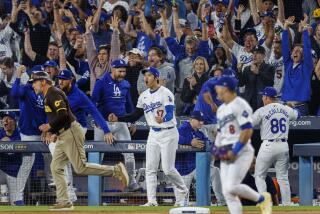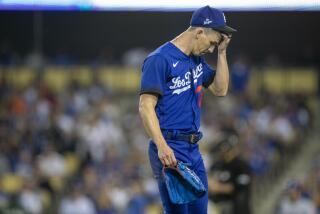Runflation : Where Have All the Pitchers Gone?
Understand first of all that there are very few pitchers. Not in the Nolan Ryan, Bob Gibson, Sandy Koufax blow-away-batters sense. Not in the Tom Seaver, Steve Carlton, Jim Palmer let’s-see-you-hit-this sense.
There are throwers, guys who somehow get by. They are impostors. But except for an occasional Greg Maddux or Randy Johnson, there are very few pitchers.
The number crunchers tell us that scoring is down and so are home runs. But that’s more a function of climactic conditions than a matter of quality pitchers. Call it April’s arctic factor.
Generally, though, as weather becomes more tolerable, hitters have flourished. The result is runflation created by pitchers whose earned run averages routinely drift between 4.00 and 5.00 per game.
So we have 11 home runs in a game between Cleveland and Milwaukee and a 12-11 game between the New York Mets and Colorado, Little League results created by throwers, not pitchers.
And we have Roger Maris’ record of 61 home runs teetering in the balance, bracing for another annual assault. Ken Griffey Jr. set a record with 13 homers in April, one less than his father hit in 1987, his best long ball season.
Less vulnerable, however, has been the .400 plateau last achieved a lifetime ago in 1941 when Ted Williams batted .406. Since then, there have only been occasional flirtations with .400, most recently by San Diego’s Tony Gwynn, who led the National League in 1994 with a .394 average.
That one needs an asterisk, though, because it was achieved in a strike season with baseball shut down after Aug. 12. Because of that, Gwynn did not have to labor through the most draining dog days of summer when punishing heat challenges the mind and spirit.
Limited to 110 games in 1994, Gwynn had 165 hits in 419 at-bats. Three more hits and he would have reached .400. Come that close and you can almost taste it. Gwynn, a seven-time batting champion, believes the goal is achievable, but not by him.
“Sooner or later, it’s going to happen,” he said. “Who does it and when he does it, who knows? It would be nice if it were me, but I don’t see it happening. My time is past.”
It should be noted he was batting .382 and coming off a three-hit game when he said that.
“It’s going to take the right guy, especially in August and September,” Gwynn continued. “That’s when you’ve got to hit. You need a lot of infield hits and I’m not getting many of those lately. You have to get a pure hitter. You need a lot of luck to achieve it, but I still think someday it’s going to be done.”
The man may be right. When he was at .382, Gwynn wasn’t even leading the league. Not close. Larry Walker was batting .433 and Jeff Blauser was at .402, the same number David Justice was hitting to lead the American League.
Now just for fun, suppose Gwynn had those three extra hits in 1994 and reached .400. Then he would have needed only 10 more--in the same 419 at-bats, of course--to break Rogers Hornsby’s single season batting average record of .424, set in 1924.
Hornsby’s magical season is among the dozen records celebrated by author Victor Debs, Jr., in his new book, “Still Standing After All These Years.”
It is a mathematical fact of life that adding points to a batting average is easy early in the season and more difficult later when at-bats add up. Hornsby defied that theorem. His average was a Gwynnian .382 at the end of June. By the end of August, two months later, it was at .434.
This is a function of getting three hits on an almost daily basis, except for the days when he had four. There was a three-game stretch of 9-for-12 in mid-July, a month when he batted .464, and another stretch of 13-for-14 in August, when he hit .509.
Hornsby’s task was made more complicated by the fact that he was not playing for a great team. His St. Louis Cardinals, managed by Branch Rickey and equipped with a less-than imposing lineup, finished sixth that season, 24 games under .500. He also had a back injury that cost him eight games in September, when he lost 10 points off his average.
Through all of this, Hornsby did have one important thing working for him, though.
There wasn’t much pitching then, either.
More to Read
Go beyond the scoreboard
Get the latest on L.A.'s teams in the daily Sports Report newsletter.
You may occasionally receive promotional content from the Los Angeles Times.










